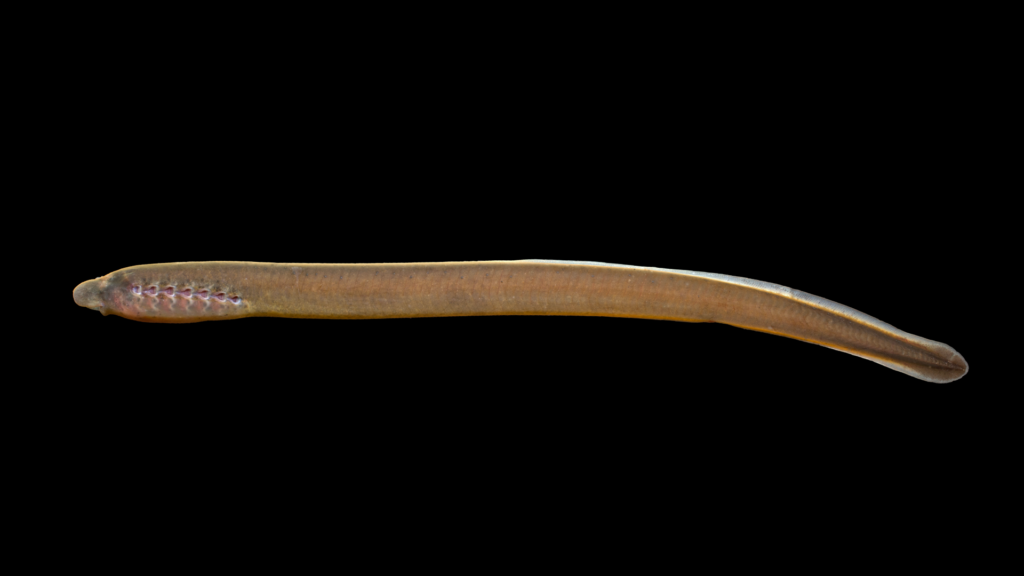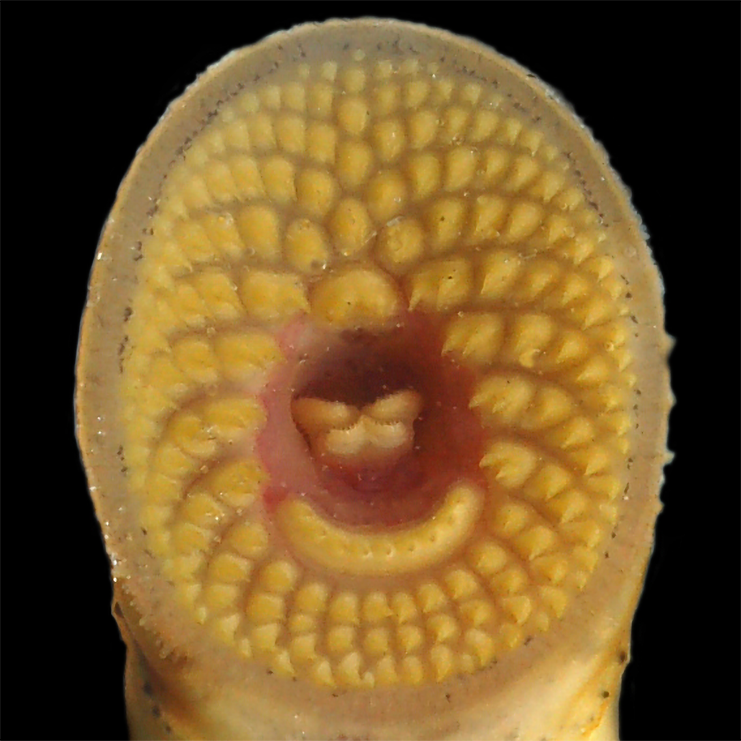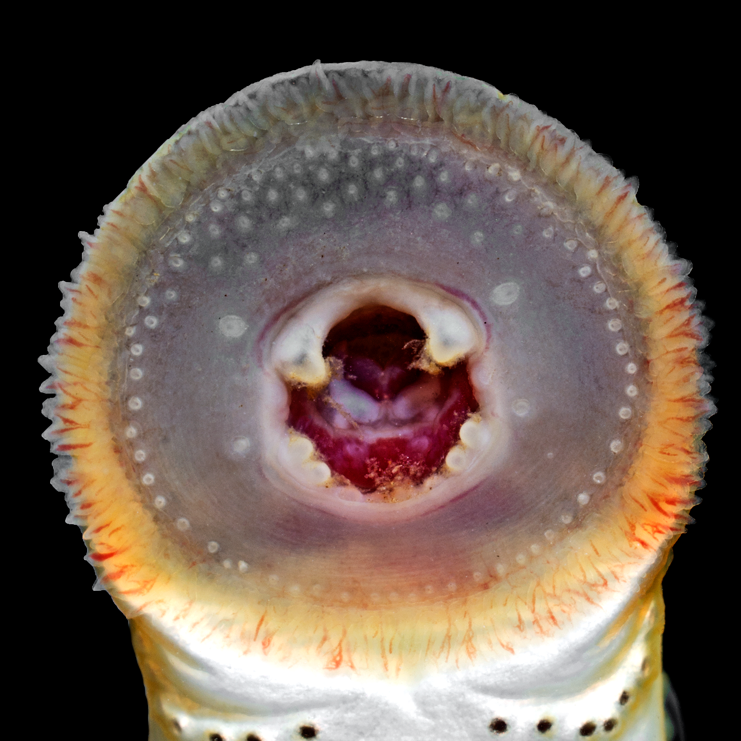By the NCFishes.com Team
In North Carolina, lampreys constitute a small family of very evolutionary primitive fishes. Most people, including fishermen, are not aware of their existence, unless one is fortunate enough to observe a spawning aggregation in the riffles of a clear Mountain or Coastal Plain stream during the late Winter or early Spring or if one has hooked a large gamefish and wondered what sort of critter was attached to it looking like something out of a science fiction movie. Lampreys are eel-like in appearance being slender, slippery, and without scales or jaws. In fact, many people think that’s what they are – some sort of eel. However, lampreys, along with hagfishes, are the most primitive of all fishes, having been around for more than 300 million years. Lampreys range in size from about 100 mm for the smaller Least Brook Lamprey up to 1200 mm (almost 48 inches) and as big around as your fore-arm for fully-grown, adult, Sea Lamprey.

In North Carolina, there are only five species (Table 1) which are widely distributed in many Mountain and Coastal Plain basins, but absent from the Piedmont (Maps 1-5) (Tracy et al. 2020). [Please note: Tracy et al. (2020) may be downloaded for free at: https://trace.tennessee.edu/sfcproceedings/vol1/iss60/1.] [Note: see Supplemental Maps 1-3 , page 13, showing North Carolina’s 100 counties, 21 river basins, and 4 physiographic regions.] Lampreys are not known to occur in the Savannah, Pigeon, Watauga, or New basins; all other basins are known to have at least one species (Tracy et al. 2020).
Table 1. Species of lampreys found in North Carolina.| Scientific Name | American Fisheries Society Accepted Common Name |
|---|---|
| Ichthyomyzon bdellium | Ohio Lamprey |
| Ichthyomyzon greeleyi | Mountain Brook Lamprey |
| Lampetra aepyptera | Least Brook Lamprey |
| Lethenteron appendix | American Brook Lamprey |
| Petromyzon marinus | Sea Lamprey |
Sea Lamprey is our most widely distributed species being found in eight basins, but historically was probably found in the Broad and Catawba basins and probably occurs in the White Oak, Waccamaw, and the Lumber but just hasn’t been detected there yet. Cope (1870a) reported Sea Lamprey from the Catawba basin, possibly as far upstream as at Morganton (Burke County), but there are no verifiable specimens to substantiate his claim (Tracy et al. 2020). In contrast to the Sea Lamprey, American Brook Lamprey is found in only one basin, the French Broad, and even there it is extremely rare, being found only in the lower reaches of Spring Creek in the Town of Hot Springs in Madison County. As compared to other families of fish, e.g., sunfishes, catfishes, and minnows, it is our understanding that no species of lampreys have been introduced outside of their native ranges in North Carolina. That is good news – let’s keep it that way!
In the right habitat in many Mountain streams, Mountain Brook Lamprey can be fairly common or abundant. However, other species are generally uncommon or rare. The immature stage of lampreys is called an ammocoete and only vaguely resembles an adult. Ammocoetes, resembling more like an earthworm than a fish, can be found in shallow, sandy, silty areas along the margins of streams. Transforming juveniles and spawning adults are found in riffles, clinging to and moving small stones and pebbles as they construct a spawning nest. Our two parasitic species, when not spawning, are attached to the sides of much larger fish.
Speaking of parasitism, juvenile and adult Sea Lamprey have been found attached to and feeding upon American Shad, Hickory Shad, catfishes, and black bass (Micropterus spp.), and other large bodied fish species. Ohio Lamprey have been observed attached to (or evidence of being previously attached to) redhorse suckers, Northern Hog Sucker, Common Carp, black bass, catfishes, and darters (Jenkins and Burkhead 1994) and River Chub. All other species, American Brook Lamprey, Least Brook Lamprey, and Mountain Brook Lamprey, are nonparasitic and non-feeding as adults. Ammocoetes of all species are filter feeders on bacteria, algae, protozoans, and fine particulate organic matter.
Sea Lamprey is an anadromous species meaning that it spawns in fresh water, migrates downstream as juveniles to live and mature in our estuarine coastal waters or the Atlantic Ocean, and then migrates back upstream, often over long distances, as sexually mature adults to spawn in small streams (Rohde et al. 1994). All of our other species are strictly freshwater inhabitants. Sea Lamprey occupy rivers and streams from the Fall Zone throughout the Coastal Plain. Ohio Lamprey inhabits medium sized to large rivers in the Mountains such as the Tuckasegee, French Broad, and Nolichucky rivers. Sometimes co-occurring with Ohio Lamprey, but more often than not, Mountain Brook Lamprey inhabit much smaller Mountain streams than the Ohio Lamprey. Least Brook Lamprey reside in sandy bottom, slow moving, slightly acidic Coastal Plain streams or small streams along the Fall Zone between the Piedmont and the Coastal Plain in the Neuse and Tar basins. As stated previously, American Brook Lamprey is only known from Spring Creek in Madison County.
Because many lamprey species are endemic to specific basins, three species are considered imperiled in North Carolina: Least Brook Lamprey, State Threatened; and Ohio Lamprey and American Brook Lamprey, Special Concern (NCAC 2017; NCWRC 2017; NCNHP 2018).
Key characteristics, which are only visible when examined under a dissecting microscope, for the proper identification of the species include the development and presence or absence of teeth on the oral disc and counting the number of trunk myomeres (please refer to Identification Key to the Species of Lampreys (Family Petromyzontidae) in North Carolina). Knowing the geographical distributions of the species (Maps 1-5) can also be useful in their identification. However, species, except for big adult Sea Lamprey and Ohio Lamprey, can be difficult to tell apart, especially the ammocoetes. Complicating matters is that several species have ranges that overlap. For example, the range of Sea Lamprey overlaps in part with that of the Least Brook Lamprey (Maps 3 and 5) and the range of Mountain Brook Lamprey overlaps in part with that of Ohio Lamprey, and American Brook Lamprey (Maps 1, 2, and 4).

If you have troubles with your identifications, just send us (https://ncfishes.com/contact/) an e-mail and include as many quality digital photographs as you can along with all the pertinent locality descriptors so that we will know from where the fish came.

